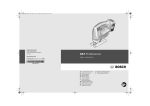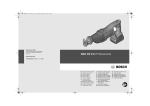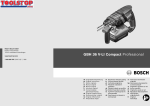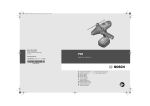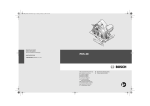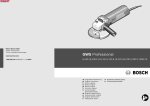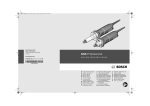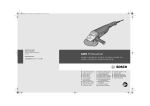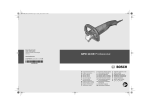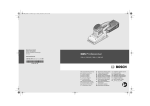Download Bosch GST Professional 135 CE Operating instructions
Transcript
OBJ_DOKU-10875-001.fm Page 1 Monday, January 21, 2008 4:20 PM Robert Bosch GmbH Power Tools Division 70745 Leinfelden-Echterdingen www.bosch-pt.com GST Professional 1 609 929 N50 (2008.01) T / 147 135 CE | 135 BCE de en fr es pt it nl Originalbetriebsanleitung Original instructions Notice originale Manual original Manual original Istruzioni originali Oorspronkelijke gebruiksaanwijzing da sv no fi el tr Original brugsanvisning Bruksanvisning i original Original driftsinstruks Alkuperäiset ohjeet Πρωτότυπο οδηγιών χρήσης Orijinal işletme talimat OBJ_BUCH-635-001.book Page 2 Monday, January 21, 2008 4:22 PM 2| Deutsch . . . . . . . . . . . . . . . . . . . . . . . . . . . . Seite 6 English . . . . . . . . . . . . . . . . . . . . . . . . . . . . . Page 17 Français . . . . . . . . . . . . . . . . . . . . . . . . . . . . Page 28 Español. . . . . . . . . . . . . . . . . . . . . . . . . . . . Página 39 Português . . . . . . . . . . . . . . . . . . . . . . . . . . Página 50 Italiano . . . . . . . . . . . . . . . . . . . . . . . . . . . . Pagina 61 Nederlands . . . . . . . . . . . . . . . . . . . . . . . . . Pagina 72 Dansk . . . . . . . . . . . . . . . . . . . . . . . . . . . . . . Side 83 Svenska . . . . . . . . . . . . . . . . . . . . . . . . . . . . Sida 93 Norsk . . . . . . . . . . . . . . . . . . . . . . . . . . . . . . Side 103 Suomi . . . . . . . . . . . . . . . . . . . . . . . . . . . . . . . Sivu 113 Ελληνικά . . . . . . . . . . . . . . . . . . . . . . . . . . . Σελίδα 123 Türkçe . . . . . . . . . . . . . . . . . . . . . . . . . . . . . Sayfa 135 1 609 929 N50 | (21.1.08) Bosch Power Tools OBJ_BUCH-635-001.book Page 3 Monday, January 21, 2008 4:22 PM 3| 5 4 3 2 1 6 7 19 18 17 16 13 12 11 10 9 GST 135 BCE Professional 8 14 15 1 4 3 GST 135 CE Professional 1 609 929 N50 | (21.1.08) Bosch Power Tools OBJ_BUCH-635-001.book Page 4 Monday, January 21, 2008 4:22 PM 4| B A 17 14 19 13 15 15 D C 20 7 7 E 20 F 9 8 21 9 6 7 1 609 929 N50 | (21.1.08) Bosch Power Tools OBJ_BUCH-635-001.book Page 5 Monday, January 21, 2008 4:22 PM 5| H G 22 9 23 24 9 23 24 I J K L 28 25 1 609 929 N50 | (21.1.08) 26 27 25 26 Bosch Power Tools OBJ_BUCH-635-001.book Page 17 Monday, January 21, 2008 4:22 PM English | 17 General Power Tool Safety Warnings en WARNING Read all safety warnings and all instructions. Failure to follow the warnings and instructions may result in electric shock, fire and/or serious injury. Save all warnings and instructions for future reference. The term “power tool” in the warnings refers to your mains-operated (corded) power tool or battery-operated (cordless) power tool. 1) Work area safety a) Keep work area clean and well lit. Cluttered or dark areas invite accidents. b) Do not operate power tools in explosive atmospheres, such as in the presence of flammable liquids, gases or dust. Power tools create sparks which may ignite the dust or fumes. c) Keep children and bystanders away while operating a power tool. Distractions can cause you to lose control. 2) Electrical safety a) Power tool plugs must match the outlet. Never modify the plug in any way. Do not use any adapter plugs with earthed (grounded) power tools. Unmodified plugs and matching outlets will reduce risk of electric shock. b) Avoid body contact with earthed or grounded surfaces, such as pipes, radiators, ranges and refrigerators. There is an increased risk of electric shock if your body is earthed or grounded. c) Do not expose power tools to rain or wet conditions. Water entering a power tool will increase the risk of electric shock. d) Do not abuse the cord. Never use the cord for carrying, pulling or unplugging the power tool. Keep cord away from heat, oil, sharp edges and moving parts. Damaged or entangled cords increase the risk of electric shock. Bosch Power Tools e) When operating a power tool outdoors, use an extension cord suitable for outdoor use. Use of a cord suitable for outdoor use reduces the risk of electric shock. f) If operating a power tool in a damp location is unavoidable, use a residual current device (RCD) protected supply. Use of an RCD reduces the risk of electric shock. 3) Personal safety a) Stay alert, watch what you are doing and use common sense when operating a power tool. Do not use a power tool while you are tired or under the influence of drugs, alcohol or medication. A moment of inattention while operating power tools may result in serious personal injury. b) Use personal protective equipment. Always wear eye protection. Protective equipment such as dust mask, non-skid safety shoes, hard hat, or hearing protection used for appropriate conditions will reduce personal injuries. c) Prevent unintentional starting. Ensure the switch is in the off-position before connecting to power source and/or battery pack, picking up or carrying the tool. Carrying power tools with your finger on the switch or energising power tools that have the switch on invites accidents. d) Remove any adjusting key or wrench before turning the power tool on. A wrench or a key left attached to a rotating part of the power tool may result in personal injury. e) Do not overreach. Keep proper footing and balance at all times. This enables better control of the power tool in unexpected situations. f) Dress properly. Do not wear loose clothing or jewellery. Keep your hair, clothing and gloves away from moving parts. Loose clothes, jewellery or long hair can be caught in moving parts. 1 609 929 N50 | (21.1.08) OBJ_BUCH-635-001.book Page 18 Monday, January 21, 2008 4:22 PM 18 | English g) If devices are provided for the connection of dust extraction and collection facilities, ensure these are connected and properly used. Use of dust collection can reduce dust-related hazards. 5) Service a) Have your power tool serviced by a qualified repair person using only identical replacement parts. This will ensure that the safety of the power tool is maintained. 4) Power tool use and care a) Do not force the power tool. Use the correct power tool for your application. The correct power tool will do the job better and safer at the rate for which it was designed. b) Do not use the power tool if the switch does not turn it on and off. Any power tool that cannot be controlled with the switch is dangerous and must be repaired. c) Disconnect the plug from the power source and/or the battery pack from the power tool before making any adjustments, changing accessories, or storing power tools. Such preventive safety measures reduce the risk of starting the power tool accidentally. d) Store idle power tools out of the reach of children and do not allow persons unfamiliar with the power tool or these instructions to operate the power tool. Power tools are dangerous in the hands of untrained users. e) Maintain power tools. Check for misalignment or binding of moving parts, breakage of parts and any other condition that may affect the power tool’s operation. If damaged, have the power tool repaired before use. Many accidents are caused by poorly maintained power tools. f) Keep cutting tools sharp and clean. Properly maintained cutting tools with sharp cutting edges are less likely to bind and are easier to control. g) Use the power tool, accessories and tool bits etc. in accordance with these instructions, taking into account the working conditions and the work to be performed. Use of the power tool for operations different from those intended could result in a hazardous situation. 1 609 929 N50 | (21.1.08) Machine-specific Safety Warnings f Keep hands away from the sawing range. Do not reach under the workpiece. Contact with the saw blade can lead to injuries. f Apply the machine to the workpiece only when switched on. Otherwise there is danger of kickback when the cutting tool jams in the workpiece. f Pay attention that the base plate 9 rests securely on the material while sawing. A jammed saw blade can break or lead to kickback. f When the cut is completed, switch off the machine and then pull the saw blade out of the cut only after it has come to a standstill. In this manner you can avoid kickback and can place down the machine securely. f Use only sharp, flawless saw blades. Bent or unsharp saw blades can break or cause kickback. f Do not brake the saw blade to a stop by applying side pressure after switching off. The saw blade can be damaged, break or cause kickback. f Use suitable detectors to determine if utility lines are hidden in the work area or call the local utility company for assistance. Contact with electric lines can lead to fire and electric shock. Damaging a gas line can lead to explosion. Penetrating a water line causes property damage or may cause an electric shock. f Hold the power tool only by the insulated gripping surfaces when performing an operation where the cutting tool may contact hidden wiring or its own cord. Contact with Bosch Power Tools OBJ_BUCH-635-001.book Page 19 Monday, January 21, 2008 4:22 PM English | 19 a “live” wire will also make exposed metal parts of the power tool “live” and shock the operator. f Secure the workpiece. A workpiece clamped with clamping devices or in a vice is held more secure than by hand. Product Features The numbering of the product features refers to the illustration of the machine on the graphics page. 1 Plastic cap f Keep your workplace clean. Blends of materials are particularly dangerous. Dust from light alloys can burn or explode. 2 Lock-on button for On/Off switch (GST 135 BCE) f Always wait until the machine has come to a complete stop before placing it down. The tool insert can jam and lead to loss of control over the power tool. 4 Handle f Never use the machine with a damaged cable. Do not touch the damaged cable and pull the mains plug when the cable is damaged while working. Damaged cables increase the risk of an electric shock. 8 Sliding shoe* 3 On/Off switch 5 Thumbwheel for stroke rate preselection 6 Extraction adapter* 7 Vacuum connection* 9 Base plate 10 Switch for sawdust blowing device 11 Adjusting lever for orbital action 12 Precision-Control button 13 Precision-Control guide cheeks Functional Description Read all safety warnings and all instructions. Failure to follow the warnings and instructions may result in electric shock, fire and/or serious injury. While reading the operating instructions, unfold the graphics page for the machine and leave it open. Intended Use The machine is intended for making separating cuts and cut-outs in wood, plastic, metal, ceramic plates and rubber while resting firmly on the workpiece. It is suitable for straight and curved cuts with mitre angles to 45°. The saw blade recommendations are to be observed. Bosch Power Tools 14 Guide roller 15 Saw blade* 16 Contact protector 17 Stroke rod 18 Dust cover for vacuuming* 19 SDS clamping lever for saw blade release 20 Vacuum hose* 21 Splinter guard* 22 Scale for mitre angle 23 Thumbwheel for pre-tension of base plate 24 Base plate clamping lever 25 Lead for the parallel guide 26 Locking screw for parallel guide* 27 Parallel guide with circle cutter* 28 Centring tip of the parallel guide* *The accessories illustrated or described are not included as standard delivery. 1 609 929 N50 | (21.1.08) OBJ_BUCH-635-001.book Page 20 Monday, January 21, 2008 4:22 PM 20 | English Technical Data Jigsaw GST 135 CE Professional GST 135 BCE Professional Article number 0 601 510 7.. 0 601 511 7.. – z Stroke rate control Stroke rate preselection z z Rated power input W 720 720 Output power W 310 310 Stroke rate at no load n0 spm 500 – 2800 500 – 2800 Stroke mm 26 26 Cutting capacity, max. – in wood – in aluminium – in non-alloy steel mm mm mm 135 20 10 135 20 10 Bevel cuts (left/right), max. Weight according to EPTA-Procedure 01/2003 ° 45 45 kg 2.6 2.7 / II / II Protection class The values given are valid for nominal voltages [U] of 230/240 V. For lower voltage and models for specific countries, these values can vary. Please observe the article number on the type plate of your machine. The trade names of the individual machines may vary. Noise/Vibration Information GST 135 CE GST 135 BCE 84 95 3 84 95 3 Measured values determined according to EN 60745. Typically the A-weighted noise levels of the product are: Sound pressure level Sound power level Uncertainty K= Wear hearing protection! 1 609 929 N50 | (21.1.08) dB(A) dB(A) dB Bosch Power Tools OBJ_BUCH-635-001.book Page 21 Monday, January 21, 2008 4:22 PM English | 21 Vibration total values (triax vector sum) determined according to EN 60745: Cutting wood: Vibration emission value ah Uncertainty K Cutting sheet metal: Vibration emission value ah Uncertainty K GST 135 CE GST 135 BCE m/s2 m/s2 6 2 5 1.5 m/s2 m/s2 6 1.5 3,5 1.5 The vibration emission level given in this information sheet has been measured in accordance with a standardised test given in EN 60745 and may be used to compare one tool with another. It may be used for a preliminary assessment of exposure. The declared vibration emission level represents the main applications of the tool. However if the tool is used for different applications, with different accessories or poorly maintained, the vibration emission may differ. This may significantly increase the exposure level over the total working period. An estimation of the level of exposure to vibration should also take into account the times when the tool is switched off or when it is running but not actually doing the job. This may significantly reduce the exposure level over the total working period. Identify additional safety measures to protect the operator from the effects of vibration such as: maintain the tool and the accessories, keep the hands warm, organisation of work patterns. Declaration of Conformity We declare under our sole responsibility that the product described under “Technical Data” is in conformity with the following standards or standardization documents: EN 60745 according to the provisions of the directives 2004/108/EC, 98/37/EC (until Dec. 28, 2009), 2006/42/EC (from Dec. 29, 2009 on). Technical file at: Robert Bosch GmbH, PT/ESC, D-70745 Leinfelden-Echterdingen Dr. Egbert Schneider Senior Vice President Engineering Dr. Eckerhard Strötgen Head of Product Certification Assembly f Before any work on the machine itself, pull the mains plug. Replacing/Inserting the Saw Blade f When mounting the saw blade, wear protective gloves. Danger of injury when touching the saw blade. Selecting a Saw Blade An overview of recommended saw blades can be found at the end of these instructions. Use only T-shank saw blades. The saw blade should not be longer than required for the intended cut. Use a thin saw blade for narrow curve cuts. Inserting the Saw Blade (see figure A) 14.12.2007, Robert Bosch GmbH, Power Tools Division D-70745 Leinfelden-Echterdingen If required, remove the dust cover 18 (see “Dust Cover”). Insert the saw blade 15 (teeth in cutting direction) into the stroke rod until it latches 17. Bosch Power Tools 1 609 929 N50 | (21.1.08) OBJ_BUCH-635-001.book Page 22 Monday, January 21, 2008 4:22 PM 22 | English While inserting the saw blade, pay attention that the back of the saw blade is positioned in the groove of the guide roller 14. 17 13 14 – Use dust extraction whenever possible. – Provide for good ventilation of the working place. – It is recommended to wear a P2 filterclass respirator. Observe the relevant regulations in your country for the materials to be worked. Dust Cover Mount the dust cover 18 before connecting the machine to the dust extraction. Note: If the grooves of the saw blade holder are not in the position shown in the figure or when the Precision-Control guide cheeks 13 are closed, then the saw blade 15 cannot be inserted into the stroke rod 17. Briefly press the SDS clamping lever 19 toward the side and release it again. f Check the tight seating of the saw blade. A loose saw blade can fall out and lead to injuries. Ejecting the Saw Blade (see figure B) f When ejecting the saw blade, hold the machine in such a manner that no persons or animals can be injured by the ejected saw blade. Press the SDS clamping lever 19 sideward to the stop. The Precision-Control guide cheeks 13 are released and the saw blade 15 is ejected. Dust/Chip Extraction f Dusts from materials such as lead-containing coatings, some wood types, minerals and metal can be harmful to one’s health. Touching or breathing-in the dusts can cause allergic reactions and/or lead to respiratory infections of the user or bystanders. Certain dusts, such as oak or beech dust, are considered as carcinogenic, especially in connection with wood-treatment additives (chromate, wood preservative). Materials containing asbestos may only be worked by specialists. 1 609 929 N50 | (21.1.08) Mount the dust cover 18 onto the machine in such a manner that the holders in the centre of the dust cover engage on the contact protector 16. For work without dust extraction, the dust cover 18 can be removed. To remove the dust cover 18, grasp it by the side and pull it off toward the front. Connecting the Dust Extraction (see figures C–E) Mount the vacuum connection 7 into the opening of the base plate 9. Make sure that the plastic tip of the vacuum connection engages into the corresponding opening on the housing as shown in the figure. Depending on the machine model, place a vacuum hose 20 (accessory) either directly onto the vacuum connection 7 or cut off the old hose end, screw the extraction adapter 6 (accessory) onto the hose end and insert it directly into the vacuum connection 7. Connect the vacuum hose 20 with a vacuum cleaner (accessory). An overview for the connection of various vacuum cleaners can be found at the end of these instructions. Switch the saw dust blower off when a dust extraction system is connected (see “Sawdust Blower Device”). To enable optimum dust extraction, use the splinter guard 21 if possible. The vacuum cleaner must be suitable for the material being worked. When vacuuming dry dust that is especially detrimental to health or carcinogenic, use a special vacuum cleaner. Bosch Power Tools OBJ_BUCH-635-001.book Page 23 Monday, January 21, 2008 4:22 PM English | 23 Splinter Guard (see figure F) The splinter guard 21 (accessory) can prevent fraying of the surface while sawing wood. The splinter guard can only be used for certain saw blade types and only for cutting angles of 0°. When sawing with the splinter guard, the base plate 9 must not be moved back for cuts that are close to the edge. Press the splinter guard 21 from below into the base plate 9 (with the notch facing upward as shown in the figure). The splinter guard 21 can be inserted into the base plate in 2 positions. For narrow saw blades, insert the splinter guard fully to the front; for wider saw blades, insert it further to the rear in the base plate 9. When using the sliding shoe 8, the splinter guard 21 is not inserted into the base plate 9, but into the sliding shoe. Sliding Shoe When working surfaces that are easily scratched, the sliding shoe 8 can be attached onto the base plate 9 in order to prevent the surface from being scratched. To attach the sliding shoe 8, insert it at the front of the base plate 9, push the rear part upward and allow it to latch. Operating Modes f Before any work on the machine itself, pull the mains plug. Orbital Action Settings The four orbital action settings allow for optimal adaptation of cutting speed, cutting capacity and cutting pattern to the material being sawed. The orbital action can be adjusted with the adjusting lever 11, even during operation. Bosch Power Tools – Select a lower orbital action setting (or switch it off) for a finer and cleaner cutting edge. – For thin materials such as sheet metal, switch the orbital action off. – For hard materials such as steel, work with low orbital action. – For soft materials and when sawing in the direction of the grain, work with maximum orbital action. Adjusting the Cutting Angle (see figure G) The base plate 9 can be swivelled by 45° to the left or right for mitre cuts. Remove the dust cover 18 and the vacuum connection 7. Release the clamping lever 24 of the base plate and lightly push the base plate 9 toward the mains cable. For adjustment of precise mitre angles, the base plate has adjustment notches on the left and right at 0° and 45°. Swivel the base plate 9 to the desired position according to the scale 22. Other mitre angles can be adjusted using a protractor. Afterwards, push the base plate 9 to the stop in the direction of the saw blade 15. Operation Setting 0 Setting I Setting II Setting III The optimal orbital action setting for the respective application can be determined through practical testing. The following recommendations apply: No orbital action Small orbital action Medium orbital action Large orbital action Close the base plate clamping lever 24 to lock the base plate in the adjusted position. The dust cover 18, vacuum connection 7 and splinter guard 21 cannot be used for mitre cuts. Offsetting the Base Plate (see figure H) For sawing close to edges, the base plate 9 can be offset to the rear. Remove the dust cover 18 (see “Dust Cover”, page 22). Release the clamping lever 24 of the base plate and push the base plate 9 toward the mains cable to the stop. Close the base plate clamping lever 24 to lock the base plate in the adjusted position. 1 609 929 N50 | (21.1.08) OBJ_BUCH-635-001.book Page 24 Monday, January 21, 2008 4:22 PM 24 | English Sawing with the base plate 9 offset is possible only with a mitre angle of 0°. In addition, the parallel guide with circle cutter 27 (accessory) as well as the splinter guard 21 may not be used. Changing the Pre-tension of the Base Plate With the thumbwheel 23, the pre-tension of the base plate clamping lever 24 can be changed. When the base plate 9 is not seated tightly after closing the lever, open the clamping lever and turn the thumbwheel for pre-tension of the base plate in the “+” direction. When the base plate cannot be adjusted or only with difficulty after opening the clamping lever, turn the thumbwheel in the “– ” direction. Precision Control Precision Control improves the lateral stability of the inserted saw blade. The lateral guidance from the Precision-Control guide cheeks 13 enable precise cuts. To switch on Precision Control, push button 12. To switch off Precision Control, press the SDS lever 19 sideward to the stop and eject the saw blade 15. Reinsert the saw blade afterwards, if required. f Wear protective gloves when changing the saw blade. The ejected saw blade can be hot. Precision Control can be used for all applications, even for mitre cuts. It is especially recommended for cuts in thick wood: The lateral guidance ensures that the cutting angle is maintained and reduces run-off of the saw blade (also see “Sawing Thick Wood”, page 25). Sawdust Blower Device With the air jet of the sawdust blower device 10, the cutting line can be kept free of dust and chips. Switching on the sawdust blower device: For cuts in materials with high removal rate, such as in wood, plastic, etc., push the switch 10 to position “I”. Switching off the sawdust blower device: For cuts in metal and when a dust extraction system is connected, push the switch 10 to position “0”. 1 609 929 N50 | (21.1.08) Starting Operation f Observe correct mains voltage! The voltage of the power source must agree with the voltage specified on the nameplate of the machine. Power tools marked with 230 V can also be operated with 220 V. Switching On and Off (GST 135 CE) To start the machine, push the On/Off switch 3 forwards. To switch off the machine, push the On/Off switch 3 toward the rear so that the “0” is indicated on the switch. Switching On and Off (GST 135 BCE) To start the machine, press the On/Off switch 3. To lock the On/Off switch 3, keep it depressed and push the lock-on button 2 to the right or left. To switch off the machine, release the On/Off switch 3. When the On/Off switch 3 is locked, press it first and then release it. Controling the Stroke Rate (GST 135 BCE) Increasing or reducing the pressure on the On/Off switch 3 enables stepless stroke-rate control of the switched-on machine. Light pressure on the On/Off switch 3 results in a low stroke rate. Increasing the pressure also increases the stroke rate. When the On/Off switch 3 is locked, it is not possible to reduce the stroke rate. Presetting the Stroke Rate With the thumbwheel for stroke rate preselection 5, the stroke rate can be preset and changed during operation. 1 – 2: 3 – 4: 5 – 6: Low stroke rate Medium stroke rate High stroke rate The required stroke rate is dependent on the material and the working conditions and can be determined by a practical trial. Reducing the stroke rate is recommended when the saw blade engages in the material as well as when sawing plastic and aluminium. Bosch Power Tools OBJ_BUCH-635-001.book Page 25 Monday, January 21, 2008 4:22 PM English | 25 After longer periods of work at low stroke rate, the machine can heat up considerably. Remove the saw blade from the machine and allow the machine to cool down by running it for approx. 3 minutes at maximum stroke rate. Working Advice f When working small or thin work pieces, always use a sturdy support or a saw table (accessory). While working, hold the machine by the handle 4 and guide it alongside the desired cutting line. For precise cuts and quiet running, guide the machine additionally with the other hand by the plastic cap 1. Contact Protector The contact protector 16 attached to the casing prevents accidental touching of the saw blade during the working procedure and may not be removed. Sawing Thick Wood For straight cuts in thick wood, please observe the following recommendations: – Switch on Precision Control for lateral guidance of the saw blade (see “Precision Control”, page 24). – Use Bosch saw blades marked with “Precision for Wood”. – Adjust the precise mitre angle using an angle measurer. – Saw applying only low feed. Orbital action and stroke ensure sufficient working process. – Always guide the machine resting firmly against the parallel guide 27 or an auxiliary guide rail. Avoid lateral pressure on the handle 4 to prevent tilting of the machine. – While sawing, hold the machine with one hand by the handle 4 and with the other hand by the plastic cap 1. Bosch Power Tools Plunge Cutting (see figures I – J) f Plunge cuts may only be applied to soft materials, such as wood, gypsum plaster boards, etc.! Use only short saw blades for plunge cutting. Plunge cutting is possible only with the mitre angle set at 0°. Place the machine with the front edge of the base plate 9 on to the workpiece without the saw blade 15 touching the workpiece and switch on. For machines with stroke rate control, select the maximum stroke rate. Firmly hold the machine against the workpiece and by tilting the machine, slowly plunge the saw blade into the workpiece. When the base plate 9 fully lays on the workpiece, continue sawing along the desired cutting line. Parallel Guide with Circle Cutter (Accessory) For cuts using the parallel guide with circle cutter 27 (accessory), the thickness of the material must not exceed a maximum of 30 mm. Parallel Cuts (see figure K): Loosen the locking screw 26 and slide the scale of the parallel guide through the lead 25 in the base plate. Set the desired cutting width as the scale value on the inside edge of the base plate. Tighten the locking screw 26. Circular Cuts (see figure L): Set the locking screw 26 to the other side of the parallel guide. Slide the scale of the parallel guide through the lead 25 in the base plate. Drill a hole in the workpiece centred in the section to be sawn. Insert the centring tip 28 through the inside opening of the parallel guide and into the drilled hole. Set the radius as the scale value on the inside edge of the base plate. Tighten the locking screw 26. Coolant/Lubricant When sawing metal, coolant/lubricant should be applied alongside cutting line because of the material heating up. 1 609 929 N50 | (21.1.08) OBJ_BUCH-635-001.book Page 26 Monday, January 21, 2008 4:22 PM 26 | English Maintenance and Service Maintenance and Cleaning f Before any work on the machine itself, pull the mains plug. f For safe and proper working, always keep the machine and ventilation slots clean. Clean the saw blade holder regularly. For this, remove the saw blade from the machine and lightly tap out the machine on a level surface. Heavy contamination of the machine can lead to malfunctions. Therefore, do not saw materials that produce a lot of dust from below or overhead. f In extreme working conditions, conductive dust can accumulate in the interior of the machine when working with metal. The protective insulation of the machine can be degraded. The use of a stationary extraction system is recommended in such cases as well as frequently blowing out the ventilation slots and installing a residual current device (RCD). Lubricate the guide roller 14 occasionally with a drop of oil. Check the guide roller 14 regularly. If worn, it must be replaced through an authorised Bosch after-sales service agent. WARNING! Important instructions for connecting a new 3-pin plug to the 2-wire cable. The wires in the cable are coloured according to the following code: If the machine should fail despite the care taken in manufacturing and testing procedures, repair should be carried out by an after-sales service centre for Bosch power tools. In all correspondence and spare parts order, please always include the 10-digit article number given on the type plate of the machine. After-sales Service and Customer Assistance Our after-sales service responds to your questions concerning maintenance and repair of your product as well as spare parts. Exploded views and information on spare parts can also be found under: www.bosch-pt.com Our customer consultants answer your questions concerning best buy, application and adjustment of products and accessories. Great Britain Robert Bosch Ltd. (B.S.C.) P.O. Box 98 Broadwater Park North Orbital Road Denham Uxbridge UB 9 5HJ Tel. Service: +44 (0844) 736 0109 Fax: +44 (0844) 736 0146 E-Mail: [email protected] Ireland Origo Ltd. Unit 23 Magna Drive Magna Business Park City West Dublin 24 Tel. Service: +353 (01) 4 66 67 00 Fax: +353 (01) 4 66 68 88 Do not connect the blue or brown wire to the earth terminal of the plug. Important: If for any reason the moulded plug is removed from the cable of this power tool, it must be disposed of safely. 1 609 929 N50 | (21.1.08) Bosch Power Tools OBJ_BUCH-635-001.book Page 145 Monday, January 21, 2008 4:22 PM | 145 2 605 438 559 2 605 730 040 2 605 510 205 2 607 001 069 2 607 010 305 2 608 000 309 2 607 001 389 MT 300 0 603 037 102 MT 300 WP 0 603 037 103 2 607 001 388 GAS 25 GAS 50 GAS 50 M Ø 19 mm: 2 607 002 161 (3 m) 2 607 002 162 (5 m) GAS 25 GAS 50 GAS 50 M Ø 19 mm: 2 600 793 009 (3 m) 1 610 793 002 (5 m) Bosch Power Tools 1 609 200 933 1 609 929 N50 | (21.1.08) OBJ_BUCH-635-001.book Page 146 Monday, January 21, 2008 4:22 PM 146 | T 144 D T 244 D T 144 DP T 101 B T 308 B T 308 BF T 101 BIF T 118 B T 123 X T 127 D T 345 XF 1 609 929 N50 | (21.1.08) Bosch Power Tools

















